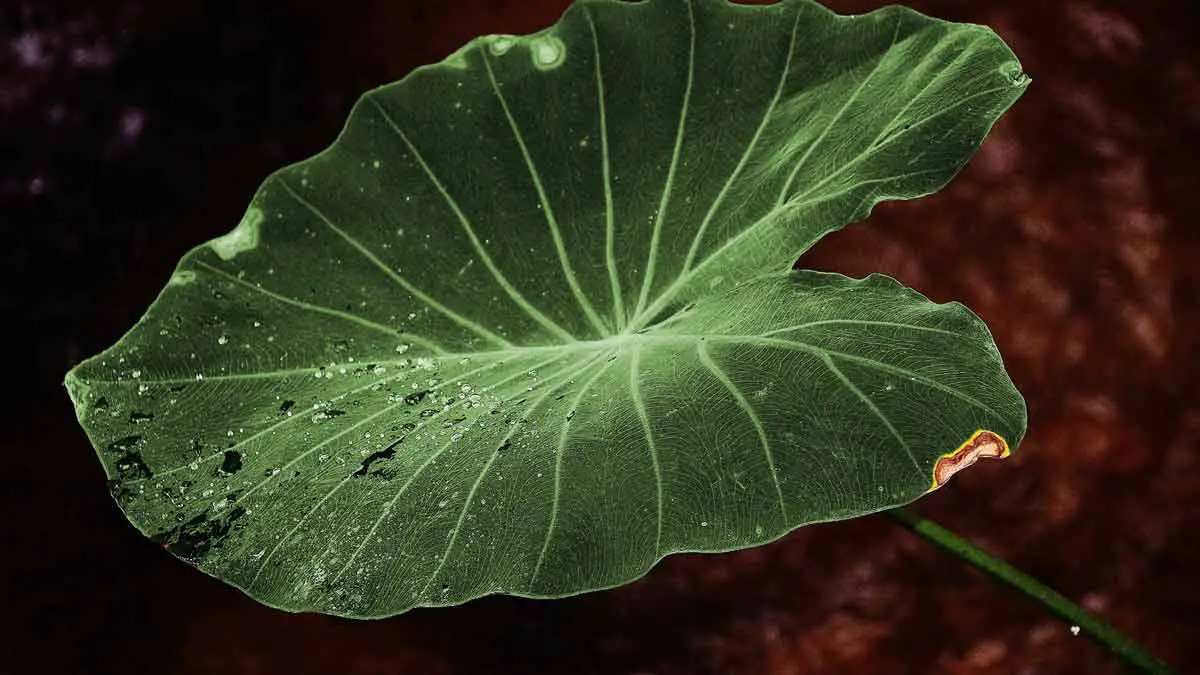Elephant ear plants can suffer from overwatering, causing yellowing, wilting, or drooping leaves and fungus growth, and potential root rot. Proper drainage, good air circulation, and keeping leaves dry can prevent these issues.
Caring for your beloved elephant ear plant can be challenging, especially when finding the perfect watering routine.
Overwatering is one of the most common mistakes that may lead to unhealthy plants and eventual demise.
But don’t worry!
We’ve got you covered with this complete guide on how to save your overwatered elephant ear plant.
Signs Of Overwatering In Elephant Ear Plants
When it comes to caring for elephant ear plants, overwatering can be detrimental.
The signs of overwatering are easy to spot and include wilting and drooping leaves, yellowing of leaves, fungus growth, and root rot.
These symptoms can occur when the soil is constantly waterlogged, preventing oxygen from reaching the roots.
It’s essential to know these signs to avoid overwatering and ensure the health and vitality of your elephant ear plant.
Wilting And Drooping Of Leaves
One of the earliest and most evident signs of overwatering in elephant ear plants is the wilting and drooping of leaves.
It may seem counterintuitive, but overwatered plants often exhibit similar symptoms to those underwatered because excess water drowns the plant roots, depriving them of oxygen, thus leading to a weakened structure unable to support healthy foliage.
To identify if your Elephant ear plant is suffering from overwatering rather than insufficient hydration, carefully inspect its leaves for other telltale signs, such as yellowing edges or soft spots on their surfaces.
In extreme cases, drooping leaves can become soggy or even fall off entirely due to excessive moisture weakening their attachment points at the base where they connect with the stem.
Yellowing Of Leaves
One clear indication of an overwatered elephant ear plant is the yellowing of its leaves.
This common issue occurs when excess water hinders the plant’s ability to absorb necessary nutrients, causing a deficiency that leads to leaf discoloration.
To address this issue and revive your elephant ear plant, it’s crucial to identify if overwatering is the culprit behind yellowing leaves.
Check the soil for moisture and examine other symptoms such as drooping or wilting foliage – both hallmark signs that your indoor plant may receive too much water.
Fungus Growth
Fungus growth is a clear indicator of an overwatered elephant ear plant.
Overwatering creates the perfect damp environment for various fungal infections to develop, as excess water and poor air circulation can lead to mold and mildew problems, affecting the overall health of your precious green companion.
To combat fungus growth on your Elephant ear leaves and soil, you should first address the watering issue and ensure proper drainage in its pot.
Be sure to remove any affected leaves from the plant carefully and avoid contact between healthy leaves and infected areas.
Additionally, using a fungicide designed for treating indoor plants like Alocasia could help control existing fungal infections while protecting against future outbreaks.
Root Rot
Root rot is a significant concern with overwatered elephant ear plants.
This fungal disease can quickly spread and damage the plant’s roots, leading to yellowing leaves that may eventually fall off.
One common symptom of root rot is brown or black, mushy roots that have a foul odor.
To prevent root rot in your elephant ear plant, make sure not to water it too frequently and ensure proper drainage by using well-draining soil and pots with drainage holes.
If you suspect your plant has root rot, it’s important to act quickly by removing any affected roots and repotting them in fresh soil to avoid further damage.
How To Save An Overwatered Elephant Ear Plant
If you’ve overwatered your elephant ear plant and notice wilting, yellowing, or mushy leaves, don’t panic.
There are steps you can take to save the plant.
A few simple tips can help your plant recover from the overwatering and thrive again.
Below, we’ll walk you through the steps you need to take to save your overwatered elephant ear plant, including checking soil moisture and drainage, trimming damaged roots and leaves, repotting the plant, and adjusting watering schedules.
Stop Watering The Plant
One of the first steps to saving an overwatered elephant ear plant is to stop watering it immediately.
Continuing to water the plant will only exacerbate the problem and cause further damage.
Giving the plant time and space to dry out
before attempting other measures.
During this time, keep a close eye on your plant’s leaves and soil moisture levels.
If you notice that some leaves have turned yellow or started wilting, remove them carefully with clean scissors or pruning shears.
Remember not to cut too many at once, as this can shock your plant and put extra stress on it.
Check The Soil Moisture And Drainage
To save an overwatered Elephant Ear Plant, one crucial step is to check the soil moisture and drainage.
Here’s what you need to do:
- Stick your finger or a moisture meter into the soil to determine if it’s too wet or dry.
- If the soil feels soggy, there’s excess water, and you need to stop watering the plant immediately.
- Check the drainage holes to ensure they’re not clogged with roots or soil, preventing proper water flow.
- If the drainage is poor, consider repotting with fresh soil and improving the pot’s drainage system.
- Ensure adequate air circulation around your plant by placing it in a well-ventilated spot.
Examine The Roots
Carefully examining the roots is essential to save an overwatered Elephant Ear Plant.
Overwatering can lead to root rot, a fungal infection that usually affects the roots of plants.
You can check for root rot by gently pulling the plant out of its pot and checking for brown or black mushy roots.
It’s also crucial to ensure that your plant has good drainage to prevent overwatering in the future.
Consider adding drainage holes to your pot if there aren’t any already and using soil that drains quickly.
Additionally, be mindful of how often you water your Elephant Ear Plant and adjust accordingly based on humidity levels and temperature.
Trim Damaged Roots And Leaves
Trimming damaged roots and leaves is vital in saving an overwatered Elephant Ear Plant.
Here’s what you need to know:
- Use a pair of sharp and clean pruning shears or scissors to trim any yellow or brown leaves.
- Cut off the roots that appear black, mushy, or have a foul smell.
- Cut away any soft or mushy areas on the remaining roots using a sterile blade.
- Trim the root ball, removing any portion that appears damaged or decayed.
- Dust the trimmed areas with fungicide powder to prevent fungal infections.
- Repot the plant in fresh soil and adjust its watering schedule accordingly.
Repot The Plant In Fresh Soil
One of the essential steps in saving an overwatered Elephant Ear plant is repotting it in fresh soil.
This process involves carefully removing the plant from its current pot, examining the roots for damage or root rot, and placing it into a new container with nutrient-rich soil.
The new pot should be one size up to allow room for growth, and the soil needs to have excellent drainage properties to avoid future cases of overwatering.
By repotting your Elephant Ear plant, you help ensure it has access to fresh nutrients while preventing fungal infections caused by stagnant water in old soil.
It’s crucial to note that while repotting can benefit an overwatered Elephant Ear plant significantly, this method may not work if the roots are too damaged or there is severe root rot.
In such cases, it might be best to cut back any damaged parts before repotting or consider propagating a healthy leaf instead.
Adjust The Watering Schedule
Adjusting the watering schedule is crucial to saving an overwatered Elephant Ear plant.
Here are some tips for watering your plant properly:
- Check the soil moisture before watering: Stick your finger into the soil up to two inches deep. If it feels moist, then wait a few more days before watering.
- Water deeply and infrequently: It’s better to water deeply than frequently as this will encourage more profound root growth. Water your plant until you see water coming out of the drainage holes at the bottom of the pot.
- Use room temperature water: Cold water can shock your plant and cause its leaves to droop.
- Adjust the watering frequency based on environmental conditions: During hot and dry weather, your Elephant Ear may need more frequent watering than during cooler weather.
- Consider using a moisture meter: A moisture meter can help determine when to water your Elephant Ear plant by indicating the soil’s moisture level.
Preventing Overwatering In Elephant Ear Plants
To prevent overwatering in elephant ear plants, one must take several precautions.
First, using the correct pot and soil is crucial.
Second, monitoring humidity levels and adjusting watering frequency based on temperature and humidity levels is essential.
Third, fertilizing regularly with appropriate organic matter or commercial fertilizer is necessary.
Lastly, controlling pest infestations is critical to maintaining the plant’s health.
Proper Watering Techniques
Proper watering techniques are essential to prevent overwatering and underwatering of elephant ear plants.
Here are some tips to ensure your plant receives the right amount of water:
- Water when the top inch of soil is dry: Overwatering can cause root rot, so it’s essential to let the soil dry out a bit before watering again.
- Water deeply but infrequently: It’s better to water thoroughly once a week than to give small amounts daily. Deep watering promotes healthy root growth.
- Use room temperature water: Cold water shocks the roots, and hot water can damage the leaves, so it’s best to use it.
- Don’t let your plant sit in standing water: Make sure your pot has drainage holes, and remove excess water from saucers after watering.
- Adjust watering schedule based on season and environment: Elephant ear plants require less water during winter when they are dormant and more during hot summer days.
Ideal Temperature And Humidity Levels
To prevent overwatering in elephant ear plants, it’s crucial to maintain ideal temperature and humidity levels.
The ideal temperature range for these tropical plants is between 60-85°F.
Temperatures above or below this range can cause stress to the plant, resulting in stunted growth or yellowing leaves.
In terms of humidity levels, elephant ear plants thrive in high humidity environments, with levels ranging from 70-80 percent.
You can place a humidifier near the plant or group other houseplants nearby to increase ambient moisture to achieve this moisture level.
Fertilization And Pest Control
Proper fertilization and pest control are essential to maintaining healthy elephant ear plants.
These tropical plants require nutrients such as nitrogen, phosphorus, and potassium to thrive.
A balanced fertilizer should be applied every four weeks during the growing season.
Pest infestations are common in elephant ear plants, especially spider mites, and fungal infections like leaf blight or powdery mildew.
Regularly inspecting the leaves for signs of white spots or webbing can prevent these infestations from becoming severe.
In addition, using organic pest control methods such as neem oil or insecticidal soap can effectively treat many pests without harming the plant.
Use The Right Soil And Pot
Choosing the right soil and pot for your Elephant Ear plant can prevent overwatering.
The ideal soil type allows good drainage while retaining enough moisture to keep the roots hydrated.
A mixture of peat moss, perlite, and sand would work well as it has a high percentage of organic matter that provides nutrients necessary for growth.
On the other hand, choosing the right pot size is equally important as it affects how much water your plant receives.
Using an appropriate container material also matters when selecting a pot because some materials, like plastic, tend to retain more moisture than others, such as clay or terracotta pots.
Clay or ceramic pots are breathable and dry out faster, which helps prevent excessive watering.
In contrast, plastic containers hold onto excess water leading to mushy roots and potential rotting issues.
Monitor Humidity Levels And Increase Air Circulation
Maintaining proper air circulation and humidity levels is crucial in preventing overwatering and keeping healthy elephant ear plants.
Increased air movement around the plant helps reduce leaf moisture, which can otherwise lead to fungal infections or pest infestations.
It’s also essential to monitor humidity levels, as high humidity combined with stagnant air can cause issues for your plant.
If you live in a dry area, regularly misting your Elephant Ear Plant will help maintain its ideal humidity level of 50 percent or higher.
And if you are growing indoors, consider investing in a humidifier.
Final Thoughts
The proper steps and care can save an overwatered Elephant ear plant.
Signs of overwatering include wilting or yellowing leaves, fungus growth, and root rot.
To save your plant, stop watering it immediately, check soil moisture and drainage, trim damaged roots and leaves, repot in fresh soil, and adjust the watering schedule.
Prevent future overwatering by using proper techniques like checking soil moisture frequently to water only when necessary.







